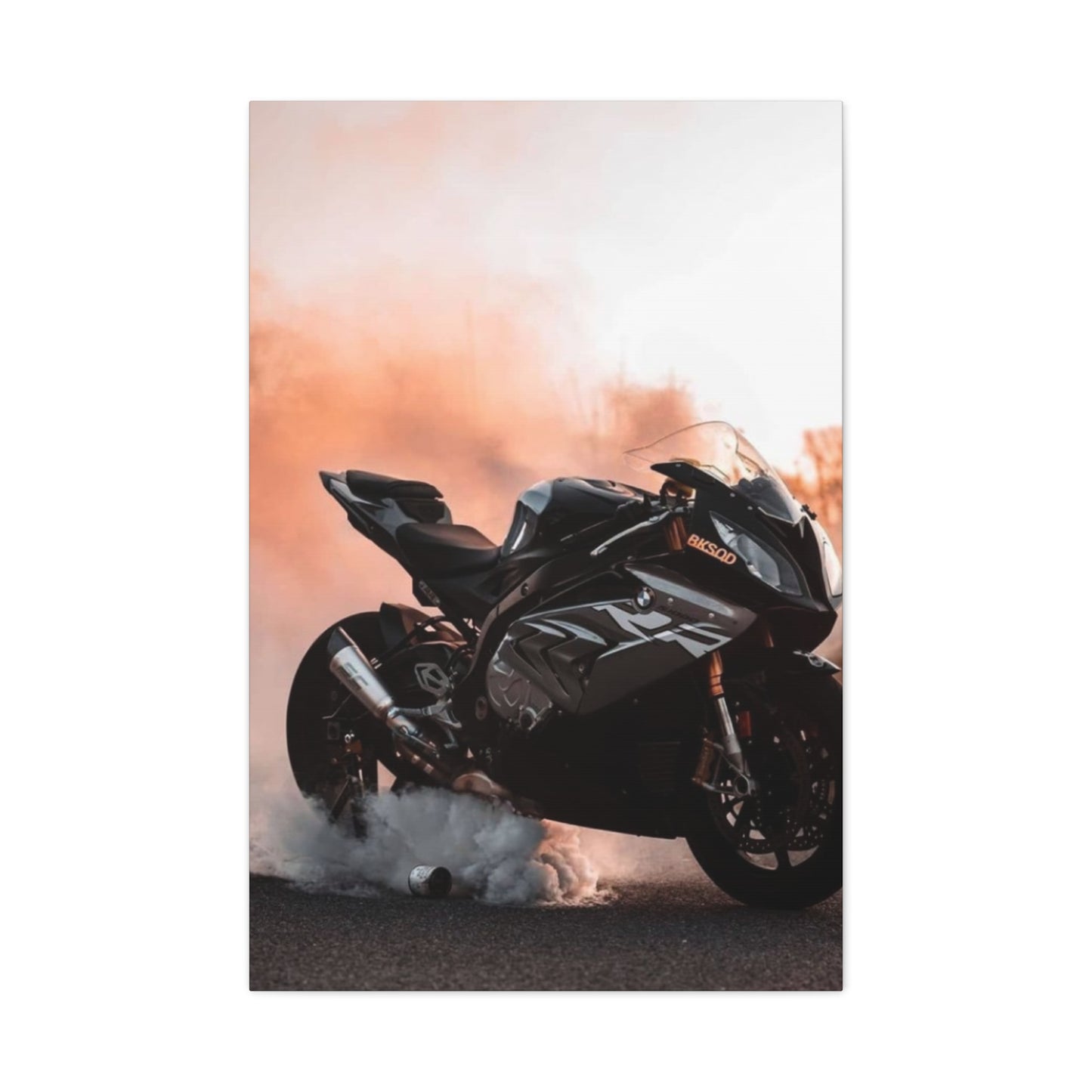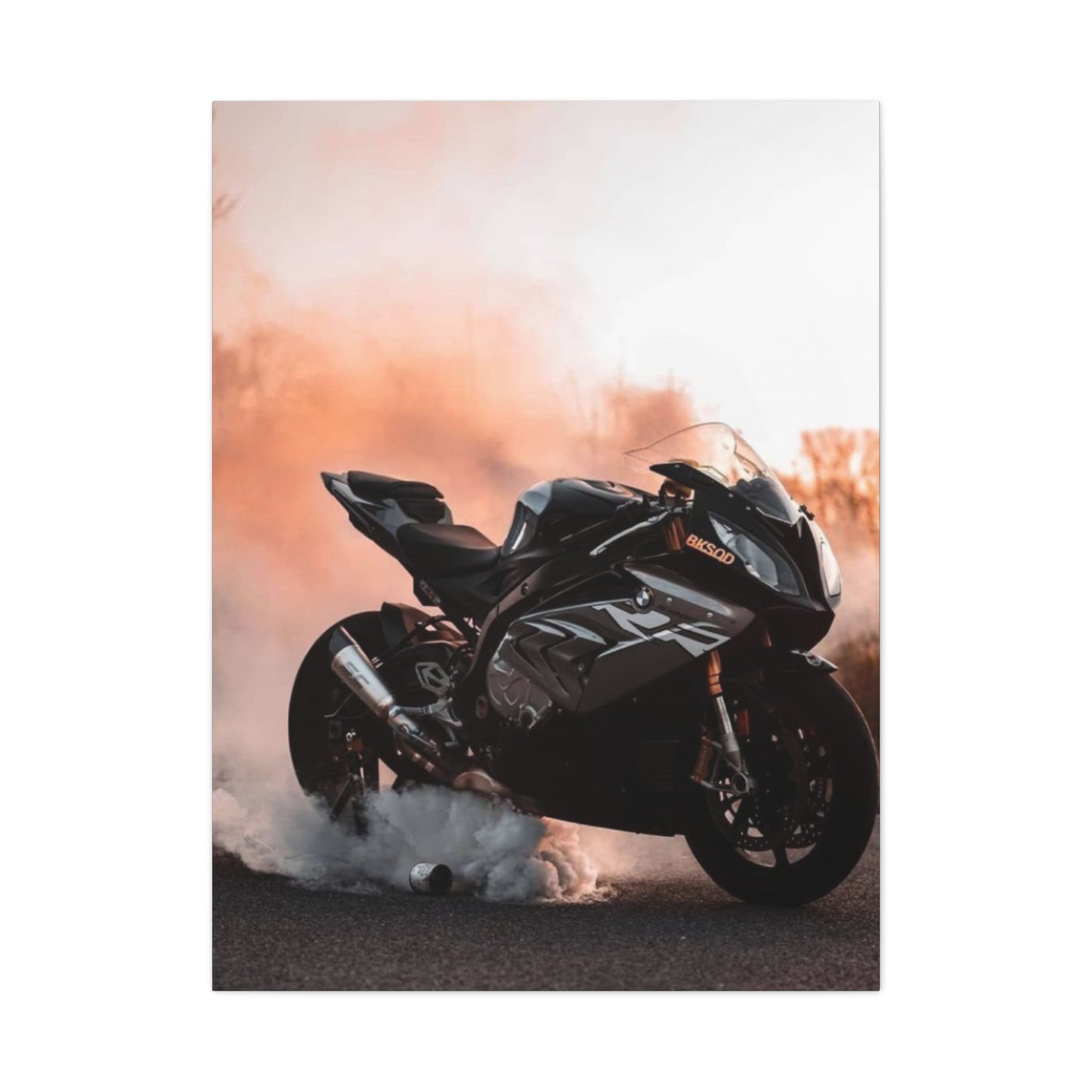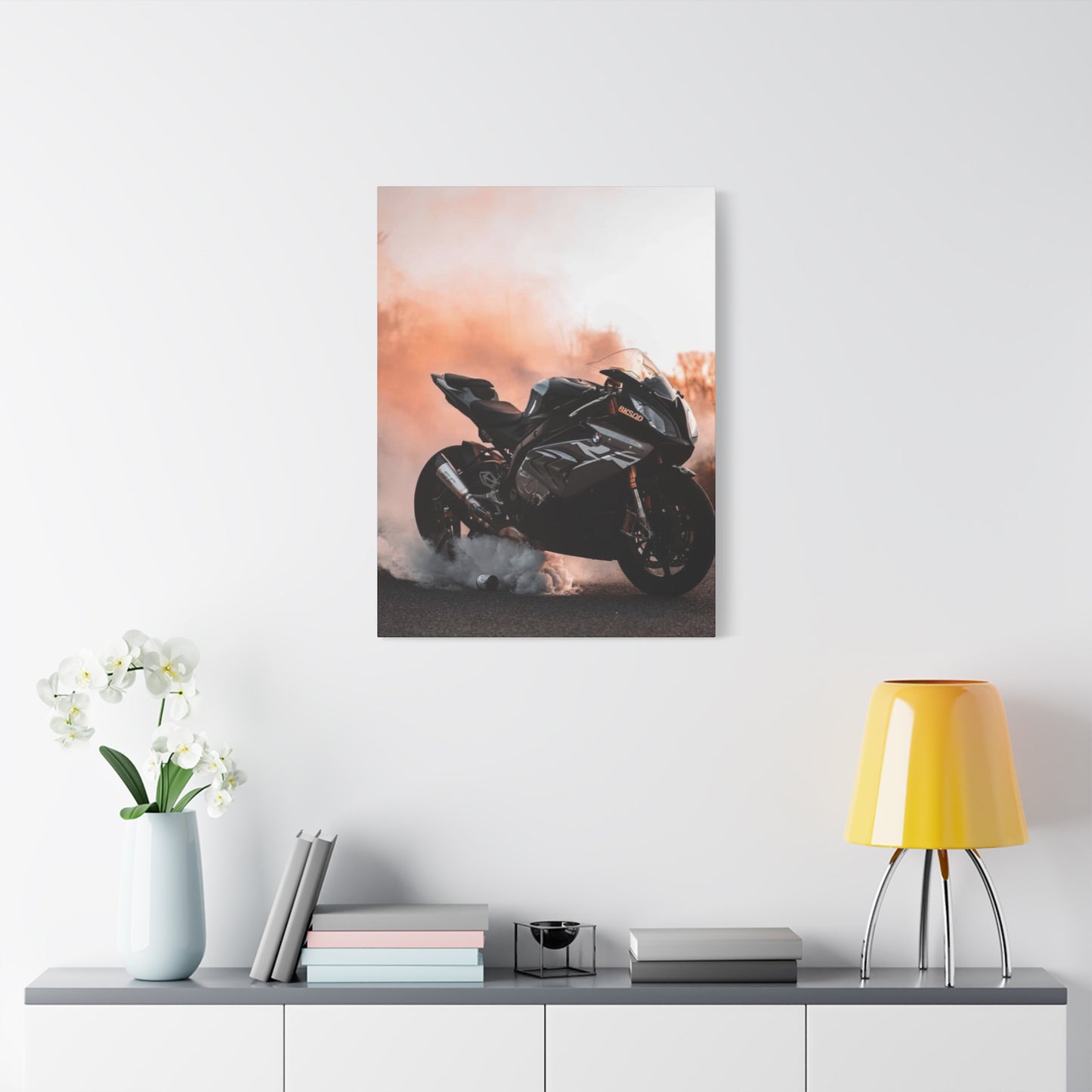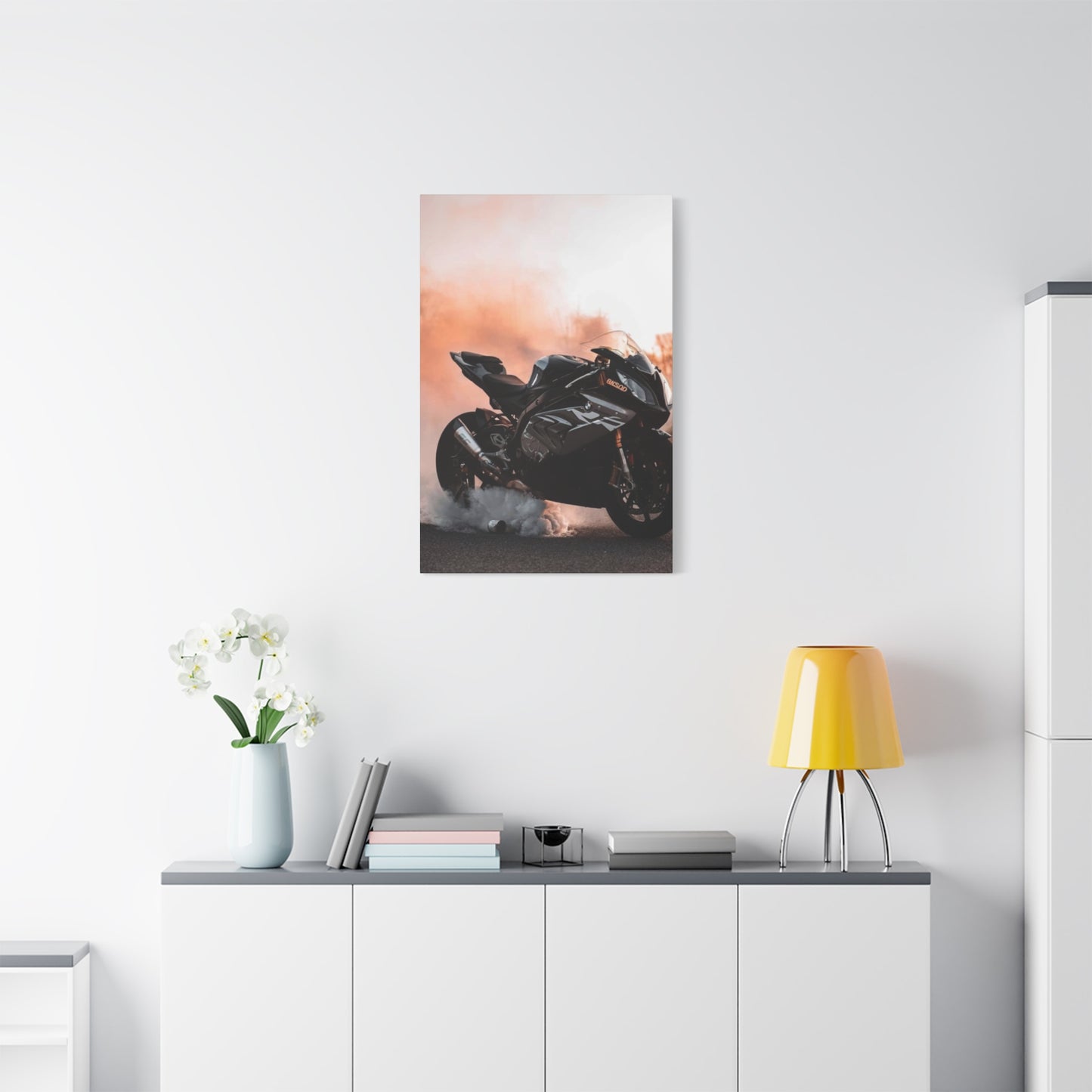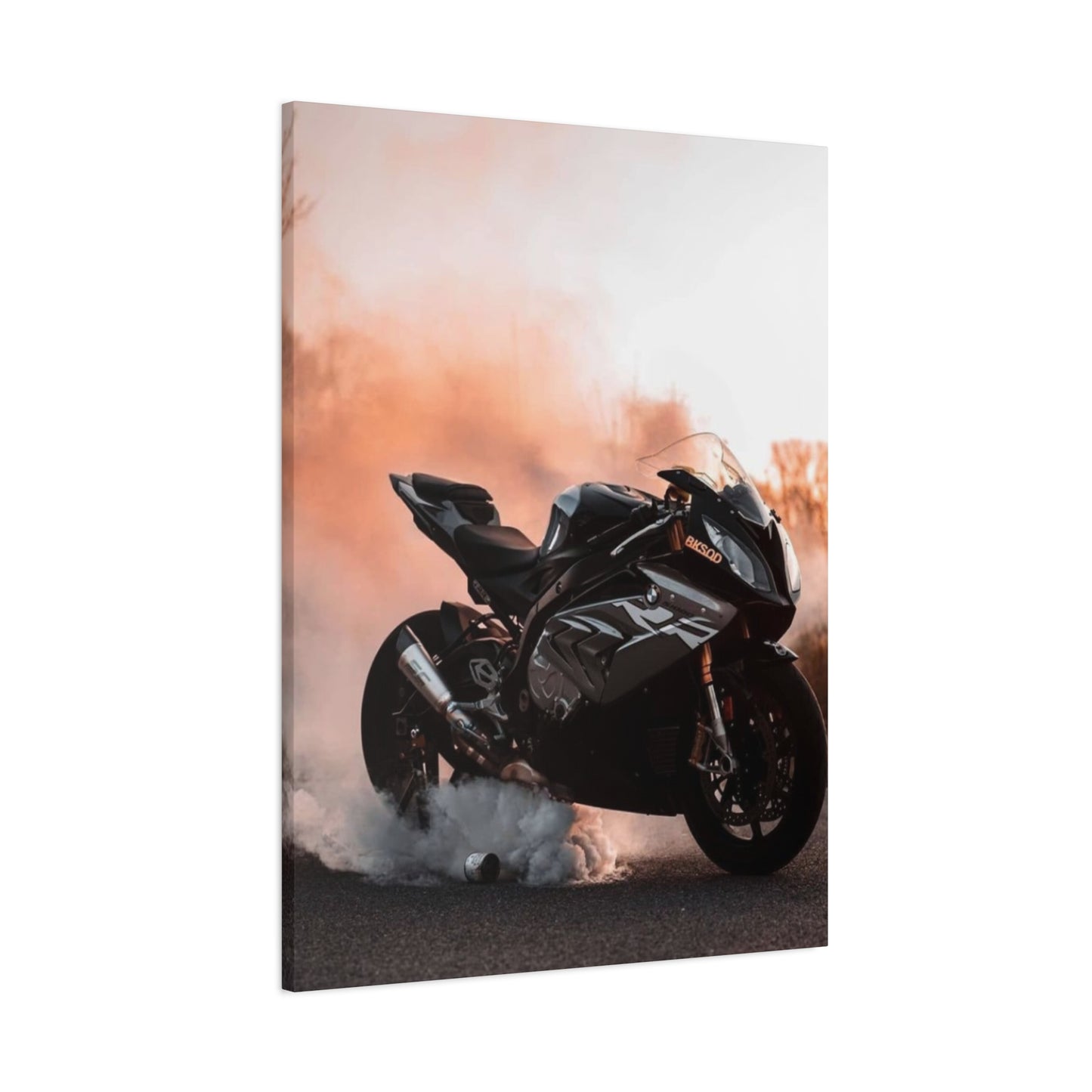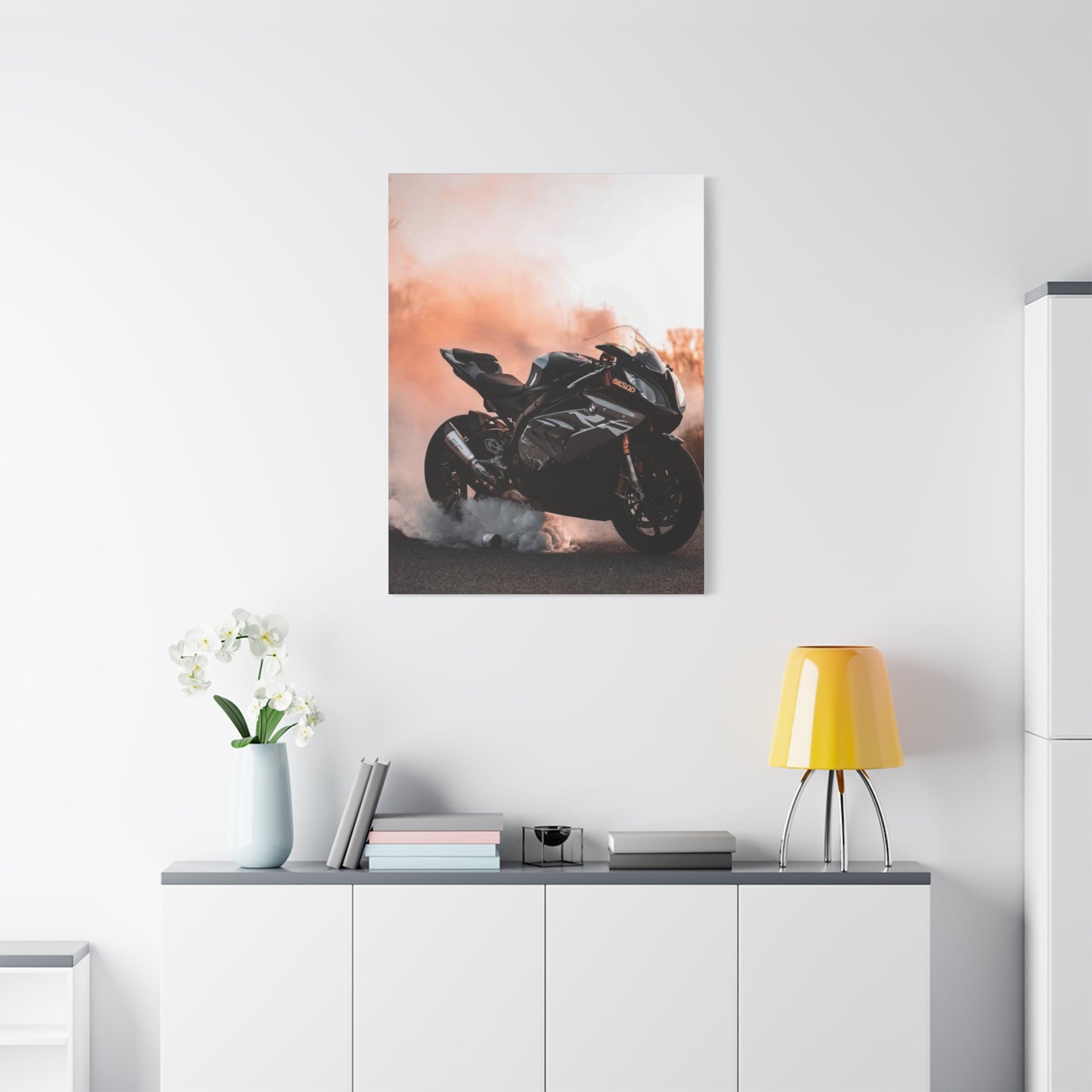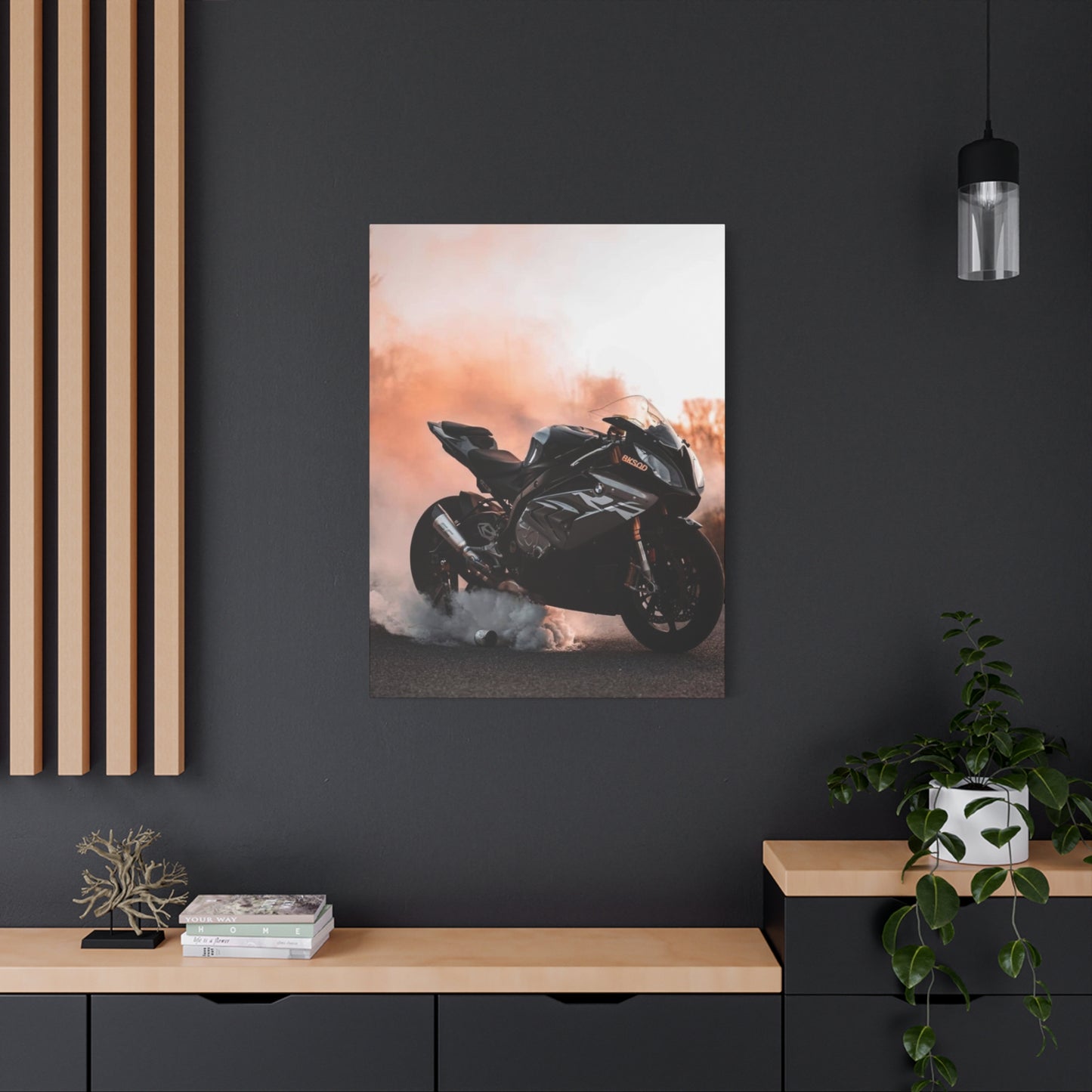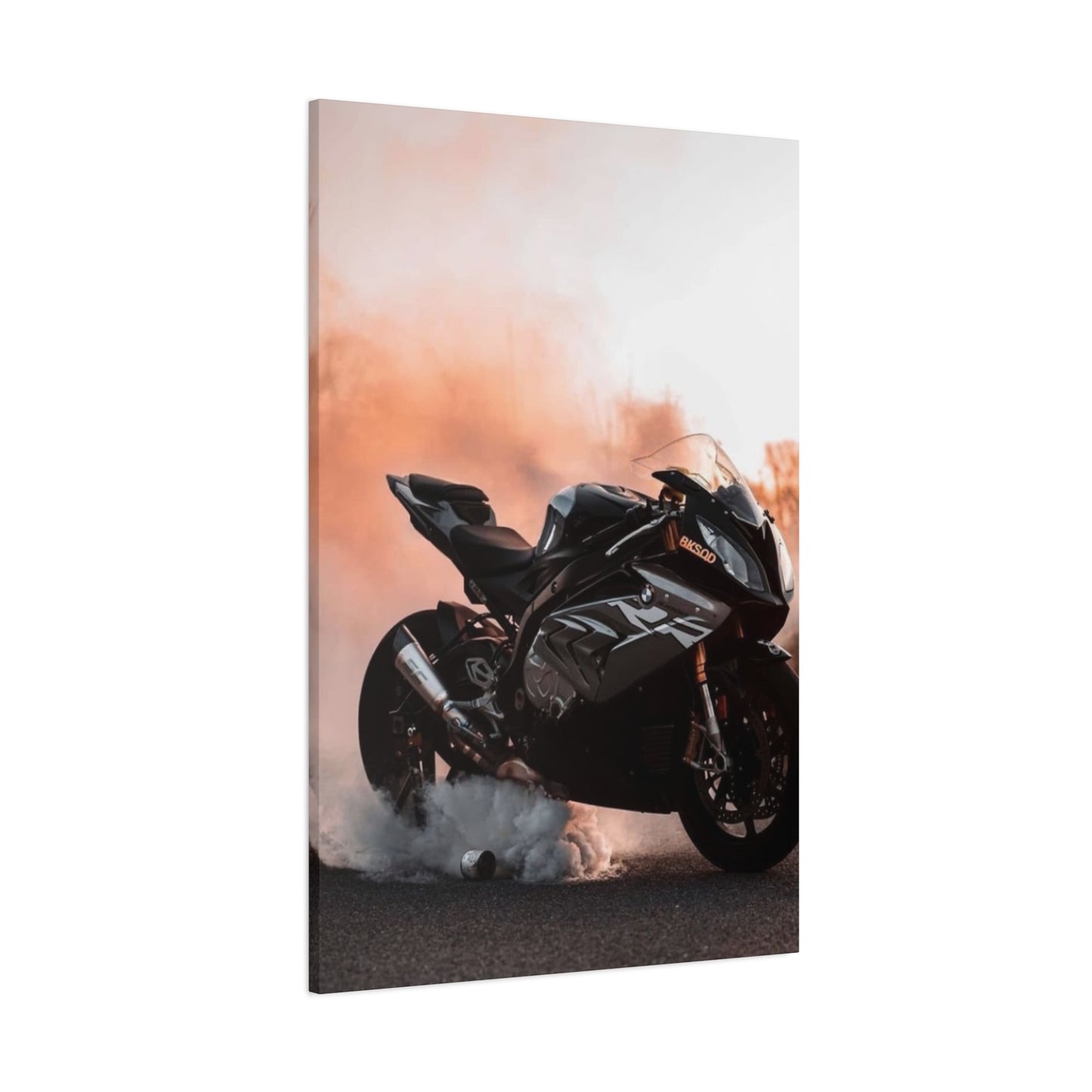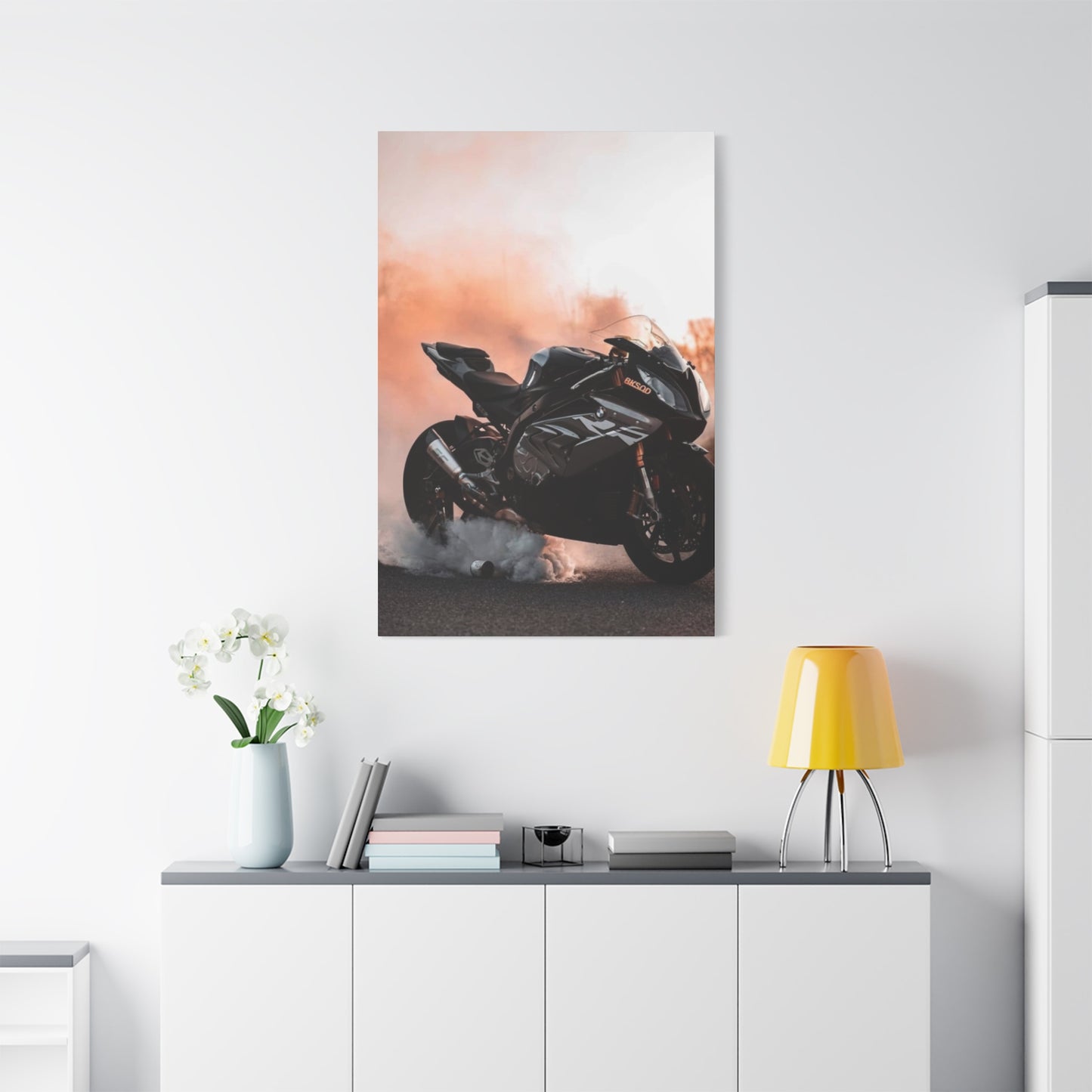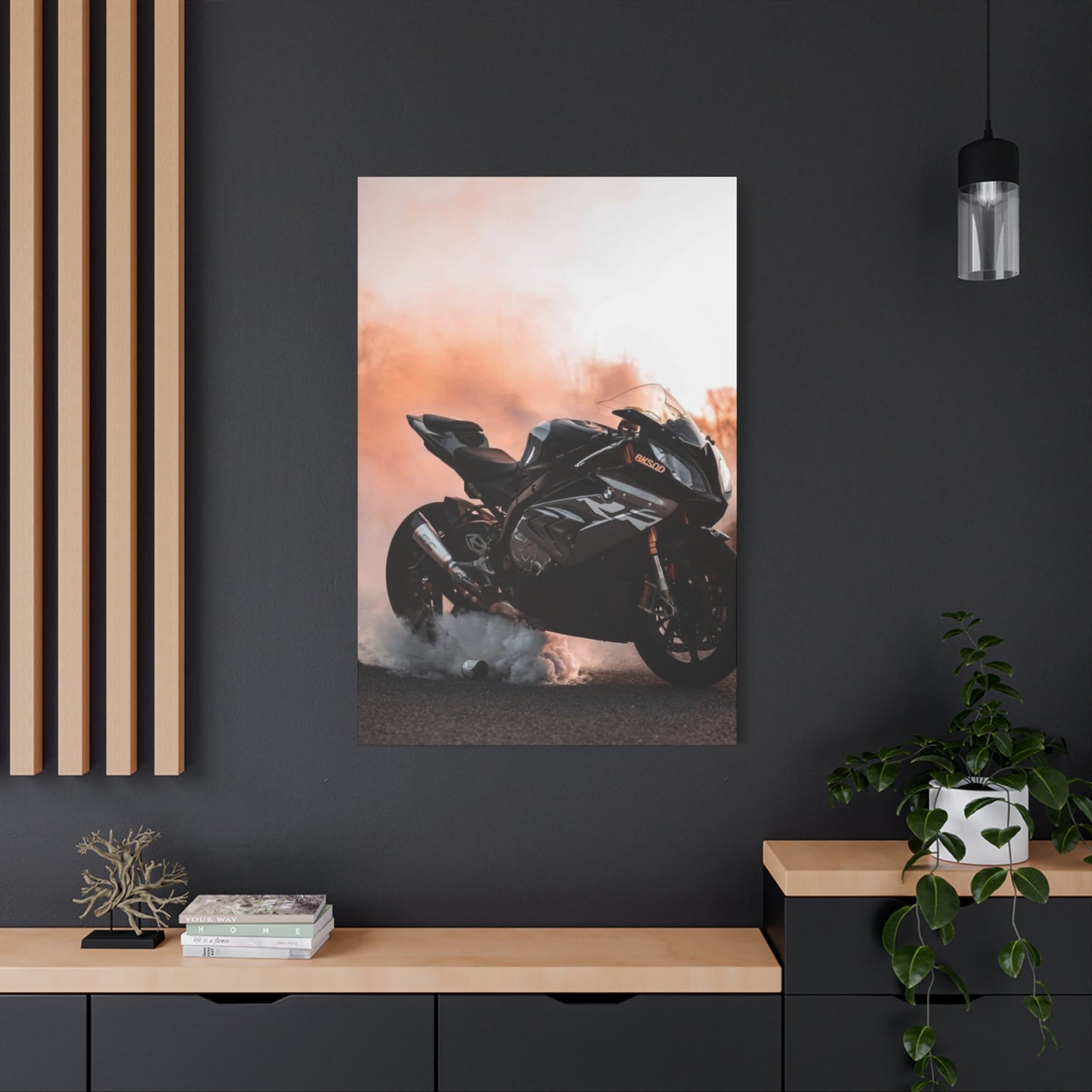The Aesthetic Appeal of Superbike Burnout Motorcycle Wall Art: Speed, Power, and Beauty on Your Walls
The roar of a superbike engine, the scent of burning rubber, and the visual spectacle of smoke billowing from spinning tires create an adrenaline-fueled experience that motorcyclists and enthusiasts cherish. Bringing this raw energy into living spaces through carefully designed canvas prints has become a powerful way to express passion for motorcycle culture. These artistic representations capture the essence of speed, power, and freedom that defines the superbike lifestyle, transforming ordinary walls into dynamic statements of personal identity and automotive appreciation.
Canvas prints featuring superbike burnout scenes offer more than simple decoration. They represent a lifestyle choice, a celebration of engineering excellence, and a tribute to the skill required to control these powerful machines. The visual impact of a motorcycle executing a perfect burnout, with rear tire engulfed in smoke while the front wheel lifts skyward, creates a frozen moment of pure mechanical aggression that resonates with anyone who appreciates performance vehicles.
The Magnetic Appeal of Superbike Burnout Imagery in Modern Spaces
Motorcycle burnout artwork possesses an inherent dynamism that few other decorative elements can match. The combination of motion, smoke, and mechanical precision captured in a single frame creates visual tension that draws the eye and holds attention. This quality makes such artwork particularly effective in spaces where energy and movement are desired aesthetic qualities.
The popularity of these canvas prints spans multiple demographics, from dedicated motorcyclists who ride daily to collectors who appreciate the artistic merit of automotive photography. The imagery speaks to fundamental human attractions to power, control, and the mastery of complex machinery. When a rider balances a superbike on its front wheel while the rear tire spins at incredible speeds, generating clouds of white smoke, the scene represents human skill pushing mechanical limits.
Interior designers increasingly recognize the value of incorporating strong focal points that reflect personal interests and passions. Superbike burnout canvas prints fulfill this role exceptionally well, providing conversation starters and establishing thematic direction for entire rooms. The contrast between the sharp mechanical details of the motorcycle and the soft, organic flow of tire smoke creates visual interest that works across various design styles.
The color palette typically found in these prints ranges from bold, saturated hues that emphasize the motorcycle's paint scheme to more subdued, monochromatic treatments that focus on form and motion. This versatility allows these pieces to integrate into diverse decorating schemes, from industrial lofts with exposed brick and metal fixtures to more refined spaces with contemporary furnishings.
Capturing Motion and Energy Through Canvas Print Technology
Modern printing technology has revolutionized how photographic images translate to canvas, allowing for unprecedented detail retention and color accuracy. The process of transforming a high-resolution photograph of a superbike burnout into a canvas print involves careful attention to color management, resolution requirements, and material selection to ensure the final product captures the energy and detail of the original moment.
High-quality canvas prints utilize archival-grade inks that resist fading from ultraviolet light exposure, ensuring the vibrant colors and deep blacks that make burnout imagery so compelling remain intact for years. The canvas material itself, typically a blend of cotton and polyester, provides a texture that adds dimension to the image while remaining durable enough to withstand environmental conditions in residential and commercial spaces.
The printing process for these canvases employs advanced inkjet technology capable of reproducing the subtle gradations in smoke density, the metallic sheen of motorcycle components, and the texture of burning rubber. This level of detail preservation ensures that even when viewed from close range, the print maintains its visual impact without revealing the limitations of the printing process.
Gallery-wrap stretching techniques, where the image continues around the edges of the wooden frame, create a three-dimensional object that projects from the wall rather than appearing as a flat surface. This mounting approach eliminates the need for additional framing, reducing visual barriers between the viewer and the image while creating a more modern, streamlined appearance.
The scale of canvas prints significantly impacts their effectiveness as decorative elements. Large-format prints measuring several feet across create immersive experiences, allowing viewers to feel almost present at the scene. Smaller prints work well in groupings or as complementary pieces within larger gallery walls, providing flexibility in how the artwork integrates into existing spaces.
Varieties of Superbike Burnout Artistic Styles and Compositions
The artistic interpretation of motorcycle burnout scenes varies widely, offering options for different aesthetic preferences and design requirements. Photorealistic representations capture every detail with documentary precision, appealing to those who value authenticity and technical accuracy. These prints often showcase specific motorcycle models, allowing brand enthusiasts to display their loyalty while appreciating the artistic presentation.
Abstract interpretations of burnout imagery focus on the motion, smoke, and energy rather than precise mechanical details. These versions might employ motion blur, selective focus, or post-processing techniques that emphasize the feeling of speed and power over literal representation. Such approaches create artwork that functions as much through mood and atmosphere as through recognizable subject matter.
Black and white treatments of burnout scenes strip away color distractions, directing attention to form, contrast, and composition. The absence of color emphasizes the texture of smoke, the contours of the motorcycle, and the interplay of light and shadow. This classical photographic approach lends gravitas and timelessness to the subject matter, elevating it beyond simple documentation to fine art status.
High-contrast, saturated color treatments amplify the visual impact of burnout imagery, pushing colors beyond natural representation to create dramatic, eye-catching results. These versions work particularly well in modern, minimalist spaces where bold accent pieces provide necessary visual interest against neutral backgrounds.
Composite images that combine multiple burnout scenes or integrate motorcycles with complementary design elements create unique artwork unavailable through single photographs. These custom creations allow for personalization and the incorporation of specific motorcycle models, color schemes, or stylistic preferences that resonate with individual tastes.
Selecting the Optimal Canvas Print Size for Maximum Impact
Determining the appropriate size for superbike burnout canvas prints requires consideration of multiple factors, including wall dimensions, viewing distance, and the desired level of visual impact. Oversized prints exceeding five feet in width create statement pieces that dominate their spaces, ideal for primary walls in living rooms, garages, or entertainment areas where bold artistic choices are appropriate.
Medium-sized prints ranging from two to four feet across offer versatility, working well as standalone pieces or within larger gallery wall arrangements. These dimensions provide sufficient scale to appreciate the detail and energy of the burnout scene without overwhelming smaller rooms or competing with other decorative elements.
Smaller canvas prints measuring under two feet work effectively in grouped arrangements, allowing the creation of triptychs or multi-panel displays that tell a visual story or show progression through a burnout sequence. These arrangements provide opportunities for creative composition while maintaining manageable individual piece sizes.
The relationship between print size and viewing distance follows principles established in photography and cinema. For maximum impact, viewers should be positioned at a distance roughly equal to one and a half times the diagonal measurement of the print. This positioning allows the image to fill peripheral vision without requiring head movement to take in the entire composition.
Room proportions influence size selection significantly. In spaces with high ceilings, vertical orientation prints or particularly tall pieces help draw the eye upward, making the room feel more balanced. Conversely, horizontal orientations work well above furniture or in spaces where width exceeds height, such as above sofas or in hallway settings.
Integration Strategies for Various Interior Design Schemes
Incorporating superbike burnout canvas prints into existing design schemes requires thoughtful consideration of color relationships, stylistic compatibility, and thematic coherence. Industrial-style spaces with exposed brick, concrete floors, and metal accents provide natural homes for these prints, as the mechanical subject matter complements the raw, unfinished aesthetic common to these environments.
Modern minimalist spaces benefit from the focused visual energy that burnout prints provide, offering necessary focal points against otherwise spare backgrounds. In these settings, the artwork often functions as the primary source of visual interest, making scale and placement particularly critical. Positioning the print against a white or light gray wall maximizes contrast and impact.
Contemporary spaces with clean lines and neutral color palettes accommodate these prints readily, especially when the artwork's color scheme coordinates with accent colors present in furnishings or accessories. Pulling specific hues from the motorcycle or background elements in the print and echoing them in throw pillows, rugs, or other decorative items creates visual cohesion.
Traditional spaces present more challenging integration opportunities but can successfully incorporate motorcycle artwork when approached thoughtfully. Selecting prints with more subdued color treatments or black and white versions helps bridge the aesthetic gap between classical design elements and modern subject matter. Framing the canvas with traditional molding can also help blend the piece into more conventional surroundings.
Man caves, garages, and dedicated hobby spaces offer the most natural venues for superbike burnout artwork, where thematic appropriateness aligns perfectly with room function. In these environments, prints can be larger, bolder, and more numerous without concern for overwhelming the space or clashing with incompatible design elements.
The Cultural Significance of Burnout Imagery in Motorcycle Communities
Within motorcycle culture, the burnout represents more than a simple display of power. It serves as a form of expression, a demonstration of control, and a ritualistic celebration of mechanical capability. Riders performing burnouts at gatherings, shows, or informal meetups create shared experiences that strengthen community bonds and establish social hierarchies based on skill and machine capability.
The visual documentation of these moments through photography captures not just the physical act but the cultural context surrounding it. Canvas prints derived from such images become artifacts that reference this broader cultural landscape, carrying meaning that extends beyond the literal content of the photograph. For enthusiasts, displaying this artwork signals membership in a community and alignment with its values.
Different motorcycle subcultures bring varying perspectives to burnout displays and their documentation. Sport bike communities often emphasize the technical precision required to maintain control during extended burnouts, viewing the act as a demonstration of rider skill. Cruiser communities might focus more on the raw power aspects, celebrating engine displacement and torque. These nuanced perspectives influence which images resonate most strongly with different audience segments.
The photography that captures burnout moments often originates from motorcycle events, races, and gatherings where photographers document the action. These images circulate through enthusiast communities online and in print media, with certain photographs achieving iconic status. When these images transition to canvas prints, they carry their cultural cachet into residential and commercial spaces.
The evolution of burnout techniques and styles influences the aesthetic qualities of the imagery. Modern superbikes with sophisticated electronics and tremendous power outputs produce different visual signatures than older, less technologically advanced machines. Current prints might showcase the precision and control enabled by traction control systems, while vintage-styled prints might emphasize the raw, unfiltered connection between rider and machine.
Material Quality Considerations for Long-Lasting Canvas Prints
The longevity and visual quality of superbike burnout canvas prints depend heavily on material selection and manufacturing processes. Premium canvas materials made from 100% cotton provide superior texture and durability compared to polyester blends, though the latter often costs less and still delivers acceptable results for most applications. The weave density of the canvas affects both durability and how well the material accepts ink during printing.
Ink quality represents another critical factor in print longevity. Archival pigment-based inks resist fading from light exposure far better than dye-based alternatives, maintaining color accuracy and contrast for decades when properly cared for. The number of ink colors used in the printing process affects color gamut and the ability to reproduce subtle tonal variations present in smoke, shadows, and metallic surfaces.
The stretcher bars over which canvas is wrapped provide structural support and determine how taut the final print remains over time. Kiln-dried solid wood bars resist warping and provide stable support, while cheaper alternatives might use composite materials that can deteriorate or change shape with humidity fluctuations. Bar thickness affects how far the canvas projects from the wall, with thicker bars creating more dramatic three-dimensional presence.
Protective coatings applied to the canvas surface after printing shield the ink from environmental factors including moisture, dust, and minor physical contact. These coatings can be matte or glossy, with matte finishes typically preferred for photographic subjects to minimize reflections and glare. Quality coatings should not alter color appearance while providing effective protection.
Edge finishing techniques impact both durability and appearance. Well-executed gallery wraps fold the canvas smoothly around corners and secure it firmly to the back of the stretcher frame, preventing sagging or loosening over time. Staple or tack placement on the back rather than sides maintains clean edges and allows the print to hang flush against the wall.
Strategic Placement Locations Throughout Home and Workspace
The effectiveness of superbike burnout canvas prints varies significantly based on placement location, with some positions naturally enhancing the artwork's impact while others diminish it. Primary living spaces including living rooms and family rooms offer high visibility, making them suitable for statement pieces that reflect the homeowner's interests and personality to guests and family members.
Garage spaces provide thematically appropriate venues for motorcycle artwork, creating cohesive environments where form and function align. In these settings, prints can be larger and more numerous without concern for aesthetic overload. The garage as a working space for vehicle maintenance or as a gathering spot for enthusiast friends becomes more inviting and personalized through thoughtful artwork selection.
Home offices and personal workspace areas benefit from artwork that inspires and energizes. The dynamic nature of burnout imagery can provide motivational visual stimulus during work hours, while also personalizing the space in ways that corporate or generic art cannot. These locations work particularly well for mid-sized prints that provide visual interest without dominating the environment.
Bedroom spaces accommodate motorcycle artwork depending on personal preference and whether the space is private or shared. For dedicated enthusiasts, waking to images of their passion creates positive associations with the space. However, the energetic nature of burnout imagery may not suit those preferring calming bedroom environments.
Entertainment spaces including media rooms, game rooms, and bars provide excellent venues for dynamic automotive artwork. The recreational nature of these spaces aligns well with the excitement conveyed through burnout imagery. Multiple prints can be arranged to create immersive environments that enhance the room's purpose.
Hallways and transitional spaces often go underutilized in terms of artwork, yet they offer excellent opportunities for creating visual interest in areas that might otherwise feel purely functional. Long horizontal prints work particularly well in these locations, drawing the eye down the space and making it feel more deliberate and designed.
Color Coordination Between Artwork and Existing Room Elements
Successfully integrating superbike burnout canvas prints requires attention to color relationships between the artwork and surrounding elements. The motorcycle itself typically provides the dominant color in these images, whether it's the bright red of a Ducati, the distinctive orange of a KTM, or the sleek black of a Kawasaki Ninja. These colors can either complement or contrast with existing room colors depending on the desired effect.
Complementary color schemes utilize colors opposite each other on the color wheel, creating vibrant, energetic combinations. A print featuring an orange superbike might pair beautifully with blue wall colors or accessories, while red motorcycles complement green tones. These high-contrast relationships amplify the visual impact of both the artwork and the surrounding space.
Analogous color schemes employ colors adjacent on the color wheel, creating more harmonious, unified appearances. A print featuring a red motorcycle might integrate smoothly into a space with orange or purple accents, creating a cohesive flow that feels intentional and carefully considered. This approach works well when seeking a more refined, sophisticated aesthetic.
Monochromatic approaches building around a single color family offer another integration strategy. Black and white prints work universally, while color prints can be selected based on the dominant hue in existing room elements. A blue superbike print might anchor a room with various shades of blue present in furnishings, rugs, and accessories.
Neutral backgrounds in prints allow the motorcycle to stand out while making the artwork more versatile across different color schemes. Prints featuring bikes against gray skies, concrete backgrounds, or minimal settings adapt more readily to various interior palettes than those with busy, colorful backgrounds that might clash with existing room colors.
Accent color strategies involve pulling a secondary color from the print and echoing it in small doses throughout the space. If tire smoke in the image has blue tones, incorporating blue accessories helps tie the artwork to the room. If background elements include warm tones, using similar warm accents in pillows, throws, or other decorative items creates connections.
Custom Creation Options for Personalized Canvas Art
Beyond commercially available prints, custom creation services allow motorcycle enthusiasts to transform their own photographs or specified images into canvas artwork. This personalization enables the display of specific motorcycle models, favorite riders, or personally significant moments captured on camera. The emotional connection to custom artwork often exceeds that possible with generic prints.
Photographers attending motorcycle events, races, or gatherings can provide source material for custom prints. High-resolution images capturing burnout moments, wheelies, or other dynamic motorcycle actions translate effectively to canvas when they meet minimum resolution requirements. Working with professional photographers ensures technical quality sufficient for large-format printing.
Personal motorcycle photographs taken during rides, at shows, or during memorable moments offer deeply meaningful subject matter for custom prints. Even amateur photography can produce effective canvas artwork when the composition, lighting, and resolution meet basic standards. Many print services offer consultation to evaluate whether specific images will produce satisfactory results at desired sizes.
Digital artists can create composite images combining elements from multiple photographs or incorporating graphic design elements alongside photographic content. These hybrid creations allow for idealized representations that might not exist in any single photograph, such as specific motorcycle models performing burnouts in fantasy locations or with enhanced visual effects.
Restoration and enhancement services can improve older or lower-quality photographs, making them suitable for canvas printing when they might otherwise lack necessary resolution or clarity. Techniques including upscaling, noise reduction, and selective sharpening can rescue images with sentimental value that don't initially meet technical requirements.
Completely original digital artwork created by skilled artists offers another custom option, allowing for stylized representations that exist purely in the imagination before being rendered digitally. These pieces can incorporate specific elements requested by the client while maintaining artistic coherence and visual impact suitable for canvas presentation.
Lighting Techniques That Enhance Burnout Print Visual Impact
Proper illumination dramatically affects how superbike burnout canvas prints appear and the impact they create within a space. Natural lighting provides the most authentic color rendering but varies throughout the day and across seasons, creating changing appearances that some view as an advantage and others as inconsistency. Positioning prints to avoid direct sunlight prevents fading while still benefiting from natural illumination.
Track lighting systems offer flexible illumination options, allowing precise positioning of light sources to highlight specific aspects of the artwork. Adjustable fixtures can be directed to graze across the canvas surface, emphasizing texture, or to illuminate the print directly from an optimal angle that minimizes glare while maximizing color vibrancy.
Picture lights mounted above the frame or canvas provide dedicated illumination that makes the artwork visible even in otherwise dim rooms. These fixtures come in various styles from traditional brass designs to modern LED strips, allowing selection based on overall aesthetic preferences. Warm-toned bulbs generally enhance the appeal of color prints, while neutral white light renders colors most accurately.
Accent lighting from the floor using uplights creates dramatic effects, particularly with larger prints. This approach works well in modern spaces and can transform the artwork into a more sculptural element, casting shadows on the wall behind and creating depth. However, this technique requires careful positioning to avoid excessive glare on glossy canvas coatings.
Ambient room lighting should be considered when determining print placement. Prints positioned opposite windows receive reflected natural light throughout the day, while those on exterior walls might require supplementary lighting to remain visible. The interaction between various light sources creates the final viewing experience, making it worthwhile to evaluate prints under different lighting conditions before final installation.
Dimmers provide control over lighting intensity, allowing adjustment based on time of day, mood, or specific activities. The ability to reduce illumination during movie watching while maintaining some visibility of wall art contributes to a more refined, controllable environment. Smart lighting systems can automate these adjustments based on time or activity patterns.
Maintenance and Care for Preserving Canvas Print Quality
Proper maintenance extends the life and preserves the appearance of superbike burnout canvas prints, protecting the investment in quality artwork. Regular dusting using soft, dry cloths removes accumulated particles that can dull colors and embed in canvas texture over time. Microfiber cloths work particularly well, attracting dust without scratching protective coatings or disturbing ink.
Avoiding direct sunlight exposure represents the most important preservation measure, as ultraviolet radiation gradually degrades both canvas material and inks regardless of quality. Positioning prints away from windows or using UV-filtering window treatments in rooms with extensive natural light protects the artwork while still allowing enjoyment of natural illumination.
Humidity control helps prevent canvas from becoming too dry and brittle or too damp and susceptible to mold growth. Maintaining indoor humidity between forty and sixty percent provides optimal conditions for canvas longevity. In particularly humid climates, dehumidifiers protect valuable artwork, while dry climates might require humidification to prevent canvas from becoming overly taut and cracking.
Avoiding touching the canvas surface prevents transfer of oils and acids from skin that can gradually degrade materials. When moving or adjusting prints, handling by the frame edges rather than touching the printed surface maintains long-term appearance. If the canvas does require cleaning beyond dusting, consulting with professional art conservators ensures appropriate techniques are employed.
Smoke exposure, whether from cigarettes, candles, or fireplaces, deposits residues on canvas surfaces that discolor and degrade materials over time. Maintaining good ventilation and minimizing smoke sources in rooms containing valuable canvas artwork preserves appearance and extends lifespan. Air purifiers with HEPA filtration can remove airborne particles before they settle on surfaces.
Periodic inspection for signs of deterioration including color fading, canvas sagging, or damage to protective coatings allows early intervention before problems become severe. Addressing issues promptly, whether through professional restoration or replacement, maintains the visual impact and value of the artwork collection.
Multi-Panel Arrangements Creating Expanded Visual Narratives
Single large canvas prints create powerful focal points, but multi-panel arrangements offer expanded storytelling possibilities and design flexibility. Triptychs featuring three related images can show progression through a burnout sequence, from initial launch through peak smoke generation to final completion. This narrative approach adds depth and interest beyond what single images provide.
Symmetrical arrangements of identical or complementary prints create balanced, formal compositions suitable for traditional spaces or over centered furniture pieces. Three identically sized prints of different motorcycles performing burnouts, for example, allow comparison while maintaining visual harmony. The spacing between panels affects whether they read as a unified composition or as distinct but related elements.
Asymmetrical groupings with varying sizes create more dynamic, contemporary appearances. A large central burnout image flanked by smaller complementary prints showing details or alternative angles provides visual hierarchy while maintaining thematic unity. This approach works particularly well in modern spaces where perfect symmetry feels too rigid.
Progressive sizing from small to large or large to small creates directional flow, drawing the eye across the arrangement in a specific sequence. This technique can emphasize particular images by positioning them at the culmination of the size progression, guiding viewer attention deliberately.
Grid arrangements with multiple same-sized prints create gallery-wall effects, particularly effective when showing various motorcycle models or different riders. The regularity of the grid provides organizational structure while the content variations maintain interest. This approach works well in larger spaces where substantial wall coverage is desired.
Vertical stacking of horizontally oriented prints creates tall, narrow compositions suitable for spaces with limited width but substantial height. Conversely, horizontal arrangements of vertical prints extend across wider spaces. Matching the arrangement orientation to the wall proportions creates more visually balanced results.
Combining Motorcycle Art With Complementary Design Elements
Superbike burnout canvas prints achieve maximum impact when integrated thoughtfully with complementary design elements rather than existing in isolation. Shelving units displaying motorcycle models, helmets, or related memorabilia create cohesive themed areas where the canvas artwork serves as the anchor piece. The dimensional objects provide textural variety while reinforcing the thematic focus.
Lighting fixtures with industrial or automotive design cues complement motorcycle artwork effectively. Exposed bulb fixtures, metal cage lights, or fixtures incorporating automotive components like headlights or turn signals create stylistic unity. These choices feel intentional rather than coincidental, strengthening the overall design concept.
Furniture selections can echo themes present in the artwork. Leather upholstery references motorcycle seat materials, while metal frame furniture with exposed welds and industrial construction parallels motorcycle engineering. These connections need not be literal to be effective; subtle nods to materials and construction methods create cohesion without becoming heavy-handed.
Textile choices including throw pillows, blankets, and rugs offer opportunities to incorporate colors from the canvas prints, creating visual connections between the artwork and functional elements. Patterns featuring tire treads, checkerboard racing flags, or abstract interpretations of speed and motion reinforce the thematic direction without requiring obvious motorcycle imagery on every element.
Accent walls painted in colors drawn from the canvas prints create strong backgrounds that make the artwork appear more integrated rather than simply hung on a generic wall. This technique works particularly well with black and white prints displayed against deep gray or even black walls, where the lack of color competition allows the tonal range and composition to dominate.
Flooring choices influence how artwork is perceived, with polished concrete, dark hardwood, or industrial-style tiles providing appropriate foundations for spaces featuring motorcycle artwork. These surfaces reference garage and workshop environments where motorcycles naturally exist, creating subliminal thematic connections that enhance authenticity.
Investment Value and Collectibility of Motorcycle Canvas Art
Limited edition canvas prints from recognized motorcycle photographers or featuring iconic moments in racing history can appreciate in value over time, particularly when properly documented and maintained. Numbered editions with certificates of authenticity establish provenance and rarity, two key factors in collectible artwork valuation. Serious collectors maintain detailed records including purchase information, edition numbers, and condition reports.
Prints featuring historically significant motorcycles or legendary riders command premium prices and tend to hold value better than generic burnout imagery. A canvas print showing a specific championship-winning bike performing a celebration burnout carries historical weight that enhances both monetary and sentimental value. Documentation connecting the image to specific events increases desirability among collectors.
Photographer reputation influences artwork value substantially. Prints from photographers known within motorcycle communities for consistently producing exceptional images command higher prices and offer better long-term value retention. Researching the photographer's background, exhibition history, and recognition within the field provides insight into whether their work represents sound investment potential.
Condition critically affects collectible artwork value, with pristine examples commanding significant premiums over damaged or poorly maintained pieces. Climate-controlled storage, proper display conditions avoiding direct sunlight, and careful handling preserve condition and maximize future value. Professional appraisals documenting condition establish baselines for insurance purposes and future sales.
Market trends in motorcycle collectibles influence artwork demand, with prints featuring currently popular motorcycle brands or styles experiencing higher demand. However, classics retain appeal across market cycles, making prints of iconic models like vintage Ducatis, Honda CB750s, or Harley-Davidson motorcycles relatively stable value propositions.
Authentication becomes increasingly important as artwork values rise, with certificates of authenticity, photographer signatures, and edition numbering providing essential documentation. Maintaining these materials with the artwork ensures provenance remains clear through ownership changes, supporting value retention.
Digital Enhancement Techniques Applied to Burnout Photography
Modern image editing capabilities allow significant enhancement of burnout photographs before canvas printing, improving visual impact while maintaining authentic representation. Color grading adjusts overall tonal characteristics, warming or cooling the image to create specific moods. Warmer tones emphasize the heat and energy of the moment, while cooler treatments create more contemporary, stylized appearances.
Contrast adjustments ensure the motorcycle stands out clearly against the background, particularly important when smoke density threatens to obscure machine details. Selective contrast enhancement targeting the bike while allowing smoke to remain softer creates visual hierarchy that guides viewer attention. Shadow and highlight recovery techniques extract detail from extreme tonal ranges that might otherwise appear as solid black or blown-out white.
Sharpening techniques applied selectively enhance critical details like motorcycle components and surface textures without amplifying noise or grain in smooth areas like sky or smoke. This selective approach maintains technical quality while ensuring important details appear crisp and well-defined at viewing distances.
Perspective correction adjusts distortions introduced by wide-angle lenses or shooting from extreme angles, ensuring the motorcycle appears properly proportioned and the horizon remains level. These corrections create more professional, polished appearances appropriate for finished canvas artwork.
Background cleanup removes distracting elements that might draw attention away from the primary subject. Power lines, intrusive signage, or cluttered elements can be eliminated or minimized, simplifying compositions and strengthening focus on the motorcycle and burnout action.
Color selective techniques isolating the motorcycle in full color while rendering the background in black and white create dramatic effects that work particularly well in canvas print format. This approach directs attention forcefully while creating striking visual interest through the contrast between color treatment methods.
Regional and International Motorcycle Art Style Variations
Different regions and countries bring distinct aesthetic sensibilities to motorcycle artwork, reflecting local riding cultures and artistic traditions. European prints often emphasize the racing heritage and technical sophistication of Continental manufacturers, with imagery frequently drawn from MotoGP, World Superbike, or Isle of Man TT events. The focus tends toward precision, engineering excellence, and sporting achievement.
American motorcycle artwork frequently celebrates the cruiser culture and open-road freedom associated with domestic manufacturers. Burnout imagery from American sources might emphasize raw power, customization, and the individualistic aspects of motorcycle ownership. The aesthetic often leans toward bolder, more aggressive presentations reflecting the American hot-rod tradition's influence on motorcycle culture.
Japanese motorcycle art reflects that nation's dominance in superbike manufacturing, with prints frequently featuring the latest technology and performance innovations from Honda, Yamaha, Kawasaki, and Suzuki. The aesthetic can range from technically focused imagery highlighting engineering details to more abstract, artistic interpretations influenced by Japanese graphic design traditions.
Australian motorcycle culture's unique character, shaped by that continent's vast distances and distinct landscape, influences local motorcycle artwork. Burnout imagery might incorporate the harsh light and distinctive colors of the Australian environment, creating prints with different atmospheric qualities than those produced in temperate regions.
Latin American motorcycle art often reflects the passionate, expressive character of regional culture, with vibrant colors and dynamic compositions. The growing motorcycle culture in countries like Brazil and Argentina produces distinctive imagery that emphasizes emotion and celebration alongside mechanical appreciation.
Middle Eastern and Asian markets show increasing interest in superbike culture, producing artwork that blends traditional regional aesthetics with contemporary motorcycle imagery. These fusion approaches create unique artistic statements that resonate with local audiences while maintaining universal appeal through the mechanical subject matter.
Psychological Impact of Dynamic Imagery in Living Spaces
The presence of dynamic, energetic artwork like superbike burnout prints influences the psychological atmosphere of spaces in measurable ways. Imagery conveying motion and power creates stimulating environments that can enhance alertness, motivation, and positive mood. These effects make such artwork particularly suitable for spaces dedicated to activity, creativity, or social interaction.
Personal identity expression through artwork selection fulfills fundamental psychological needs for self-determination and authentic self-presentation. Displaying prints that reflect genuine interests and passions creates living spaces that feel personally meaningful rather than generically decorated. This authenticity contributes to overall life satisfaction and comfort within one's own environment.
Conversation facilitation represents another psychological benefit of distinctive artwork. Superbike burnout prints provide natural discussion topics when guests visit, creating opportunities for social connection through shared interests or curious inquiry about unfamiliar subjects. This social lubrication effect can be particularly valuable for individuals who appreciate having conversation starters available.
Aspirational imagery can serve motivational functions, reminding viewers of goals, values, or achievements they pursue. For motorcyclists working toward track days or performance riding skills, burnout imagery might represent aspirational capabilities they seek to develop. This regular visual reinforcement can support goal pursuit and maintain motivation during challenging periods.
Stress relief through engagement with passion-related imagery offers another psychological benefit. For enthusiasts unable to ride as frequently as desired due to work, weather, or other constraints, motorcycle artwork provides vicarious engagement with the hobby. This connection, while not replacing actual riding, offers psychological benefits between riding opportunities.
Territorial personalization through distinctive artwork creates psychological ownership of spaces, particularly important in shared living situations or rental properties where permanent modifications aren't possible. Canvas prints provide significant personalization without requiring permission or creating permanent changes, offering psychological benefits of ownership and control over one's environment.
Commercial Applications in Businesses Serving Motorcycle Enthusiasts
Motorcycle dealerships benefit substantially from well-chosen canvas artwork featuring superbike burnout imagery. These prints reinforce brand identity when featuring the specific manufacturers the dealership represents, create aspirational atmospheres that encourage purchasing, and signal authentic enthusiasm for the products being sold. The visual excitement of burnout imagery generates emotional responses that facilitate sales conversations.
Motorcycle repair and customization shops create more inviting, professional environments through thoughtful artwork selection. Waiting areas transformed from purely functional spaces into galleries celebrating motorcycle culture make service appointments more pleasant for customers while reinforcing the shop's expertise and passion. The artwork serves as silent testimony to the business's commitment to motorcycle culture beyond mere commercial transaction.
Motorcycle gear and apparel retailers use dynamic canvas prints to establish brand atmosphere and differentiate themselves from generic sporting goods stores. The artwork signals specialized focus and authentic understanding of customer needs, building trust and creating memorable shopping experiences. Seasonal rotation of prints featuring different riding conditions or motorcycle types maintains visual interest for repeat customers.
Motorcycle-themed restaurants and bars leverage burnout imagery to establish authentic environments that attract target demographics. The artwork provides visual interest while reinforcing the establishment's concept and brand identity. For venues hosting rider meetups or serving as gathering spots for motorcycle clubs, appropriate artwork becomes part of the value proposition.
Motorcycle museums and halls of fame utilize high-quality canvas prints to supplement their physical collections, showing motorcycles in action rather than simply displayed statically. Burnout imagery captures the dynamic nature of motorcycles in ways that static displays cannot, helping visitors understand the excitement and performance these machines offer when operated.
Motorcycle track day organizations and racing schools create motivational environments through strategic artwork placement in classroom and common areas. Seeing professional riders or dramatic action shots reinforces the skills being taught and the exciting possibilities that await students as their abilities develop.
Environmental Considerations in Canvas Print Production
Environmentally conscious consumers increasingly consider the ecological impact of their purchases, including decorative artwork. Canvas print production involves multiple environmental considerations from material sourcing through manufacturing processes and shipping. Understanding these factors allows informed choices that align purchasing decisions with environmental values.
Canvas material sourcing affects environmental impact significantly. Cotton canvas from organic, sustainably managed farms carries lower environmental costs than conventionally grown cotton requiring pesticides and substantial water inputs. Alternatively, canvas made from bamboo or hemp offers rapidly renewable options with minimal agricultural inputs. Recycled polyester blends incorporate post-consumer waste streams, reducing demand for virgin petroleum-based materials.
Printing processes vary in environmental impact based on ink types and energy sources. Water-based inks produce fewer volatile organic compound emissions than solvent-based alternatives, improving indoor air quality and reducing atmospheric pollution. Solar-powered printing facilities or those purchasing renewable energy credits reduce the carbon footprint associated with the energy-intensive printing process.
Wooden stretcher frames sourced from sustainably managed forests certified by organizations like the Forest Stewardship Council ensure replacement planting balances harvest, maintaining forest cover over time. Alternatives including bamboo or reclaimed wood frames offer additional environmentally sensitive options that reduce demand for virgin timber.
Packaging materials and shipping methods influence overall environmental impact. Minimal packaging using recycled or biodegradable materials reduces waste, while carbon-offset shipping programs compensate for transportation emissions through investments in renewable energy or reforestation projects. Local production when available eliminates long-distance shipping entirely.
Durability and longevity represent crucial environmental considerations often overlooked. High-quality canvas prints lasting decades avoid the environmental costs of replacing inferior products every few years. This durability factor can justify higher initial costs from an environmental perspective, as the per-year environmental impact decreases with extended product life.
End-of-life considerations address what happens when prints are eventually retired. Canvas can potentially be removed from stretcher frames and recycled or repurposed for other applications. Wood frames might find new uses or be recycled into composite materials. Products designed with eventual disassembly and material recovery in mind reduce long-term environmental impact.
Final Thoughts
Superbike Burnout Motorcycle Wall Art isn’t just a tribute to speed—it’s a celebration of the raw power, precision, and beauty that define the world of superbikes. The intense, adrenaline-fueled moments captured in these artworks bring the energy and excitement of a burnout into your living space, creating an atmosphere of boldness and vitality. Whether you're a motorcycle enthusiast, a lover of high-octane action, or someone who simply appreciates the artistry of motion and design, this wall art transforms your room into a dynamic homage to the thrilling world of superbikes.
The aesthetic appeal of Superbike Burnout Motorcycle Wall Art lies in its ability to capture the power and motion of the motorcycle in a way that feels both visceral and artistic. Each image reflects the heart-pounding moment of a burnout—where rubber meets asphalt, smoke billows, and raw energy pulses through the frame. But beyond the technical precision of the machine, there’s a beauty in the way the artwork freezes this moment in time. The swirl of smoke, the blurred wheels, and the sharp lines of the bike against the backdrop of the open road evoke not just power but grace. The colors, textures, and composition create a sense of movement and intensity, making it feel as though the bike is in perpetual motion, even when it’s hanging on your wall.
This wall art brings a sense of thrill and passion into any space, transforming an ordinary room into a celebration of speed and power. It’s perfect for spaces where energy and excitement are key elements—whether that’s a modern living room, a man cave, or even a home office that thrives on inspiration and intensity. The striking imagery of the burnout adds an edge to your decor, becoming a focal point that draws the eye and fuels conversation. It's not just a decoration; it’s a statement—one that says you're not afraid to embrace the bold, the powerful, and the beautiful in life.
The versatility of Superbike Burnout Motorcycle Wall Art also lies in its ability to seamlessly blend with various design styles. For a modern, industrial space, the gritty, high-impact nature of the burnout art complements the sleek, raw elements of exposed brick, metal fixtures, and minimalist furnishings. In more eclectic or bold interiors, the dramatic imagery adds a layer of excitement and dynamic energy, breaking up monotony and creating visual interest. Whether you place it in a bedroom, living area, or even a garage or workshop, this wall art infuses the space with a sense of adventure, freedom, and the thrill of the open road.
Furthermore, the Superbike Burnout Motorcycle Wall Art connects deeply with those who live for the thrill of the ride. It evokes the exhilarating sensation of the open road, the wind in your hair, and the power of a finely tuned machine beneath you. For motorcycle enthusiasts, this art piece is more than just decor; it’s an extension of their passion, a visual representation of the adrenaline that courses through them every time they rev the engine. It’s a way to bring the heart-pounding excitement of the track into your everyday life, whether you're a rider yourself or someone who simply admires the craft of superbike design.
In addition, this artwork captures a sense of freedom—of breaking away from the everyday and pushing the limits of what's possible. The burnout moment symbolizes a release of energy and a statement of independence, making it a powerful reminder of the importance of embracing one's passions and living fully. It's a celebration of the pursuit of power and beauty, both in the motorcycle and in the life it represents.
In conclusion, Superbike Burnout Motorcycle Wall Art is a perfect blend of speed, power, and beauty that elevates any space. It’s more than just a piece of decor; it’s a visual embodiment of the thrill, freedom, and intensity of the superbike world. Whether you're a motorcycle lover, a fan of dynamic art, or simply someone looking to add excitement and energy to your home, this artwork is a bold choice that will continue to inspire, captivate, and energize your space for years to come.


















